Today we break down the core strategy for small capital to turn around in the crypto space — controlling positions + rhythm is the key!
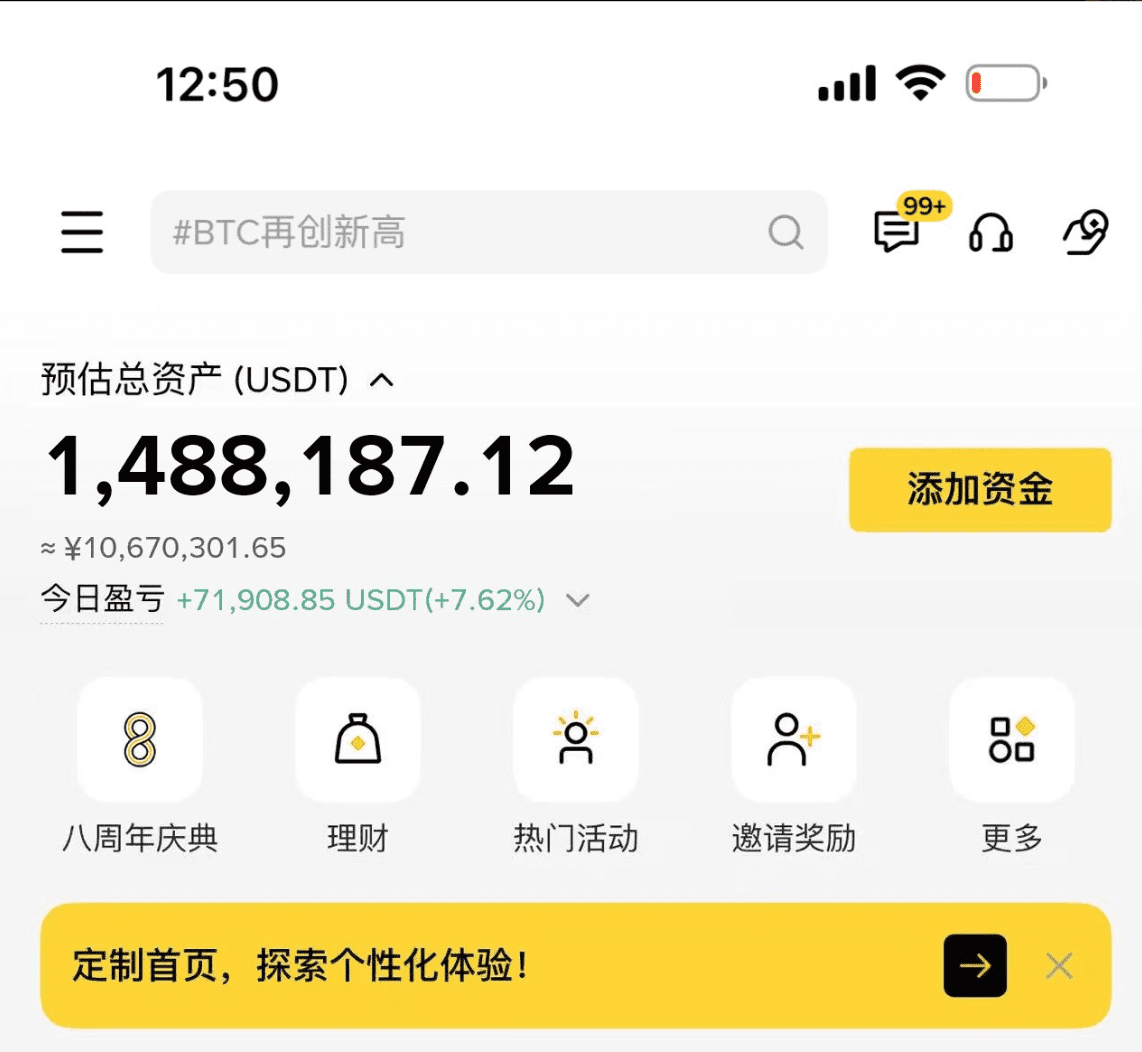
1. Diversifying is like building a fortress: split 1000U into 'three pieces of lifeline'.
First segment: 300U initiation point
Use only 30% of your capital for the first order, specifically targeting 'MACD golden cross + increased volume' signals!
Never add positions without a signal, don’t catch falling knives, and don’t stubbornly hold on to losses — small capital cherishes life, every cent must be spent wisely!
Second segment: 500U to watch the trend wave.
Leave the remaining funds for 'big market confirmation' before taking action (for example, BTC breaking through the previous weekly high), and during consolidation periods simply shut down, avoiding meaningless operations!
Third segment: 200U as a revival armor.
Even if the first two trades lose everything, this 200U can still let you 'revive'!
In the 2023 bear market, I helped my students turn the tide three times with this trick!
2. Only trade at points you are confident in: divide the market into 'three pieces of meat'.
Capture the first wave: test and error with light positions when the trend appears, lock in profits as soon as you earn 10%!
Second wave: add to positions when the retracement does not break the previous low, using 30% of profits to expand gains!
Third wave continuation: after the trend is clear, strike heavily, but never exceed 30% of your capital!
Remember: volatile markets are meat grinders; better to be in cash than to gamble blindly!
3. Profit rolling: let the money give birth to its own children.
Earned 100U on the first trade? Immediately treat this 100U as new capital!
Floating profit of 10%: use 50% of the profit to add positions, and pocket the remaining 50%! Floating profit of 30%: withdraw another 20% profit as a 'safety cushion'!
Core principle: profits generate profits; never gamble with your principal!
4. Take profits when there is a gain: I withdraw first when others are crazy.
While others chase up and get liquidated: I take profits and leave, securing my earnings!
While others panic sell and cry: I enter at the right rhythm and profit from the retracement!
Don't aim for the entire segment, but ensure you profit from every segment — flipping is built on compound interest, not on gambling!
The secret to surviving in the crypto space for small capital is not 'betting on rises and falls', but 'executing simple rules to the extreme'!

Survival rules in the crypto space: stop loss and minimal actions, preserving capital is key to surviving until the end.
After years in the crypto space, the most painful realization is not 'guessing the wrong direction', but being drained of capital by 'blind operations' and 'not cutting losses'.
Are you constantly repeating this cycle?
Seeing the market jump, immediately chase the price, fearing to miss the 'get rich opportunity'; as a result, just after entering, it retraces, comforting oneself that 'it will rise back soon', getting stuck deeper and deeper.
Finally, panic selling and then chasing the next hot stock... The account balance diminishes in the cycle of 'chasing up - cutting losses - chasing again'.
The essence of losing money is making two fatal mistakes:
Frequent trading: on the surface, it seems to seize opportunities, but in reality, it becomes a 'fee slave'.
Every time you rush to place an order, you are amplifying risk; what's more frightening is that frequently switching tracks can cause you to lose direction amidst market fluctuations.
No stop loss: Holding onto the hope of a 'lucky comeback' is equivalent to running naked with your principal. A single retracement can wipe out all profits and even erode the principal.
True trading wisdom is 'survive first, then talk about making money'.
Stop loss is not admitting defeat; it's giving your trades 'insurance'. Just like wearing a seatbelt when driving seems redundant, it can save your life at critical moments.
Before placing an order, ask yourself: 'How much loss can I accept at most?' When reaching the stop loss point, decisively exit to preserve capital for a comeback.
Reject frequent trading: the market is never short of opportunities, but opportunities do not come every day. The market has cycles — buy when it's suitable to layout, wait when it's time to observe, and leave when it's time to exit. Rather than blindly chasing highs and cutting losses, it's better to calm down and wait for the real opportunity.
Remember: the essence of trading is risk management, not chasing huge profits. Avoiding one impulsive chase means reducing one point of being stuck; increasing one stop loss means increasing the confidence in preserving capital.
Preserving capital allows you to survive longer, waiting for the moment that truly belongs to your profits.
Making 1 million in the crypto space: 'either rely on a big bull market and hold on, or bet on a wealth coin, or use high leverage to bet in the right direction'. But most people lose money, so don’t just look at wealth stories; first, think clearly about how much risk you can bear.
If you are also a tech-savvy crypto enthusiast, click on the coin homepage.
Click on my profile picture to follow me and gain access to first-hand information and in-depth analysis!

5 minutes to understand | SMA vs EMA: Which moving average is more suitable for your crypto trading strategy?
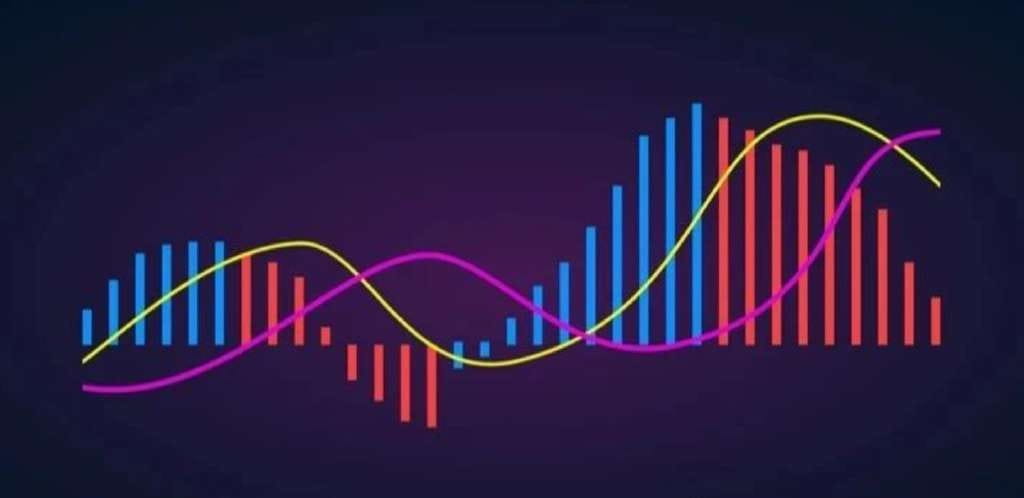
Whether it is SMA (Simple Moving Average) or EMA (Exponential Moving Average), it cannot be said that one is 'better' than the other, as they serve different trading purposes.
SMA excels in long-term trend analysis and stability by giving equal weight to all periods to reduce false signals; EMA reacts more quickly to price changes, making it more suitable for short-term trading and more volatile markets.
The choice of which moving average to use depends on individual trading style, time frame, and market conditions. Understanding their respective advantages allows one to select the tool that best suits their trading needs.
Brief overview:
◔ No moving average 'completely wins' — SMA is more suitable for long-term trend analysis, while EMA is better for short-term trading.
◔ In less volatile markets, the SMA provides more reliable signals by averaging all period data.
◔ EMA reacts quickly to price changes, thus performing better in highly volatile short-term trades.
◔ SMA is better at identifying sustained trends and support/resistance levels, while EMA is better at capturing short-term market reversals.
◔ Which is 'better' depends on trading style — long-term investors prefer the stability of SMA, while day traders favor the sensitivity of EMA.
Overview – Simple Moving Average vs Exponential Moving Average.
The key difference between SMA and EMA lies in their calculation methods, which determines their responsiveness to price changes.
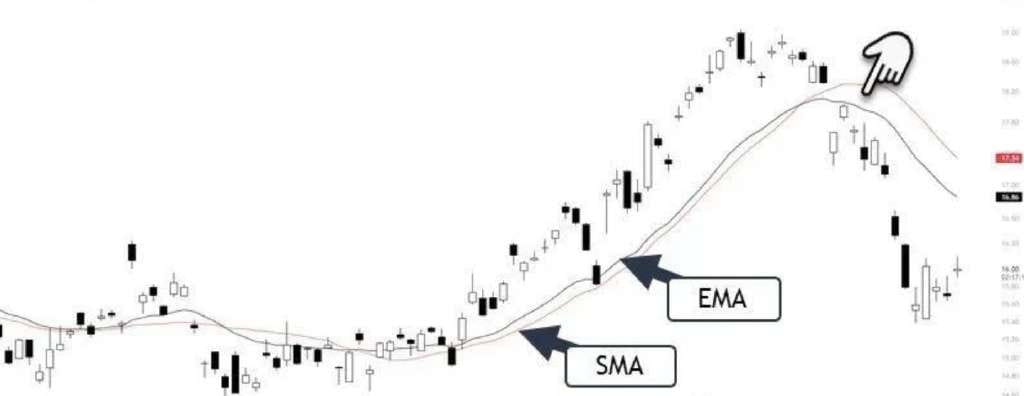
SMA (Simple Moving Average) is the standard average of prices over a selected period, with equal weight given to each price data point, which can more accurately reflect the average price over the selected look-back period. However, the SMA reacts slowly to price fluctuations, especially sudden price movements. In trending markets, the SMA often lags behind price candlesticks more than the EMA.
The calculation of EMA (Exponential Moving Average) includes weighted handling of recent prices, allowing it to respond more quickly to price movements. Therefore, the EMA line will be closer to the price candlestick. However, it should be noted that the faster the response, the greater the possibility of false signals.
Performance in volatile markets
The left side of the chart is an area worth noting. Moving averages are calculated based on closing prices, so when the market enters a consolidation phase with small distances between closing prices, the price will fluctuate repeatedly near the moving average. For breakout traders, a quick glance at the moving averages can provide an initial judgment of which assets are in consolidation.
The pointer position on the right side of the chart shows a gap down in price. Here, it is clear that the EMA reacted faster than the SMA. While the SMA still maintained an upward trend, the EMA had already turned downward. This is because the EMA gives more weight to recent data.
When prices move steadily, the difference between using the same period SMA and EMA will be minimal.
Will longer periods have an impact?
The previous example used a more common parameter setting (period of 20). If we extend to commonly used trend-following moving averages like the 200-day SMA and EMA, do they show any differences?
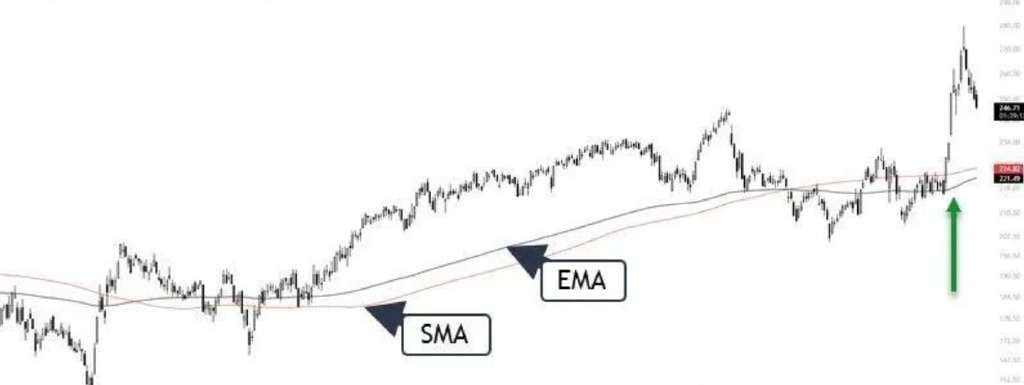
Practical tests show that no matter how you use moving averages in trading, the choice of which one to use usually does not change the core strategy. The green arrows show that the EMA reacts faster to large fluctuations but does not provide any additional valuable information for the strategy.
Trading application methods
Traders use moving averages in various ways within their strategies. Personally, I find price action more important than moving averages. I use moving averages only to construct a market structure framework and do not make trading decisions solely based on moving averages.
So, how do we determine whether to use SMA or EMA? We can analyze based on price crossing the moving average as a trend determination method, and price retracing to the moving average as an entry opportunity.
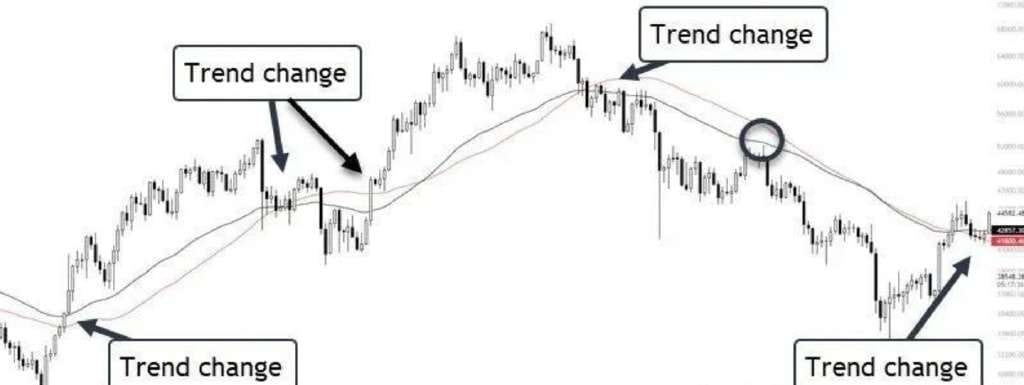
If we regard price crossing the moving average as a signal of trend change, it turns out that regardless of which moving average is used, the impact on trading bias is not significant. In fact, the double top formation and subsequent breakdown trend appearing in the middle of the chart provide signals earlier than any moving average.
When the price retraces near the moving average, the black circle area in the chart is the only spot that has not touched the moving average. For most traders, 'close enough' is sufficient, especially in cases where the price breaks down after oscillating within a range, which can be considered an effective shorting opportunity.
Which moving average should be used?
The differences between SMA and EMA are minimal and should not substantially affect a mature trading system. As for the optimal parameter settings, there is no 'one correct' answer.
Short-term traders usually prefer indicators that respond quickly, so they may choose the 10-day EMA or SMA for short-term operations. Some traders will observe whether prices run along the 10-day SMA to look for breakout signals after short-term oscillations.
Long-term traders prefer indicators that react slowly to price changes, often using the 50-day or 200-day SMA to assess the overall trend. As shown in the 200-period comparison, although the EMA reacts faster, the difference it brings is not significant.
Additionally, different periods of moving averages can be combined: for example, using the 100-day SMA to determine the long-term trend, and using the 10-day EMA to identify counter-trend trading opportunities.
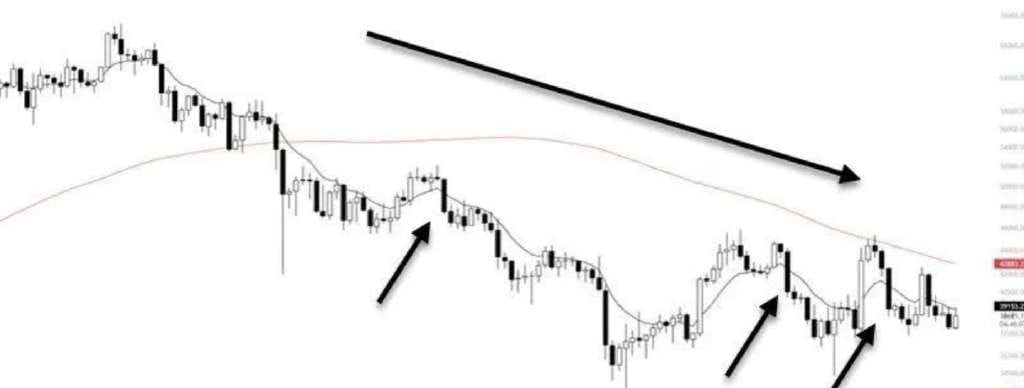
Using the latest chart of Bitcoin, the 100-day Simple Moving Average (SMA) shows a downward trend as the current price operates below it.
When the price briefly rises above the faster 10-day EMA and then closes below it, traders may consider shorting. However, this is not a trading strategy that can be applied directly; it must be thoroughly tested.
You need to clarify: how far below the EMA does the price need to be to trigger an entry? Is just one closing price below the EMA sufficient, or does the entire candlestick need to be below it?
Frequently Asked Questions
1. Can moving averages consistently and accurately predict market crashes?
Moving averages cannot consistently and accurately predict market crashes. They can identify trend reversals and suggest market weakness, but are essentially lagging indicators that follow prices rather than provide early warnings. Relying solely on moving averages to time the market is often unreliable. Market crashes typically occur suddenly and are driven by complex economic and psychological factors that technical indicators cannot capture alone.
2. How do institutional traders typically combine SMA and EMA?
Institutional traders often use both SMA and EMA simultaneously to confirm market trends and identify more robust entry signals. They usually observe longer-term SMA (like 200-day) to grasp the overall market direction, while using short-term EMA (like 20-day) to seize trading opportunities. This combination helps them reduce false signals and enhance the effectiveness of trading decisions: the slow SMA provides trend background, while the fast EMA captures the latest price dynamics.
3. Do moving averages perform differently in the cryptocurrency market compared to traditional markets?
In the cryptocurrency market, the performance of moving averages indeed differs due to the higher volatility and faster changes in market sentiment. In contrast, traditional markets are generally more stable, making moving averages more reliable as indicators. In the cryptocurrency market, shorter-period moving averages are more popular, as they can adapt more quickly to price changes. Therefore, cryptocurrency traders often need to adjust the moving average periods and combine them with other indicators to suit the unique characteristics of the crypto market.
4. In a high-inflation economic environment, which moving average periods perform best?
During periods of high inflation, short-term moving averages like the 10-20 day often perform better because they reflect price changes more quickly. Longer periods like the 50-day or 200-day may miss market sentiment shifts triggered by inflation news. The most effective strategy is usually to use multiple timeframes: short-term moving averages for entry and exit references and long-term moving averages to filter the overall trend, forming a more comprehensive strategy system.
5. How do moving averages perform during black swan events?
During black swan events, moving averages often struggle to keep up due to extreme market volatility. Their lagging nature can render them ineffective during sharp price movements, leading to sluggish or erroneous signals. In such events, investor sentiment changes drastically, and both short-term and long-term moving averages may become distorted. Traders should rely more on other technical indicators and strict risk management measures at this time.
Conclusion
The debate regarding SMA (Simple Moving Average) versus EMA (Exponential Moving Average) ultimately depends on personal trading needs. EMA reacts more quickly to price changes, while SMA provides more stable signals. There is no absolute superiority or inferiority between the two — trading success lies in the ability to apply the right tools to your trading style, time frame, and market environment. Traders should test both before practical use to find the method that best suits their strategy.

Ten years of trading coins, blood and tears summary: six iron rules for small capital to turn around.
After ten years of trading coins, I finally understand: for small capital to turn around, it's not luck, but knowledge and execution. These six iron rules, earned with youth, are heart-wrenching.
1. Kick the 'gambling mentality' and embrace compound interest.
Forget about 'getting rich overnight'; remember the 'miracle of compound interest'. Turning 10,000 into 1 million requires flipping it seven times, not a one-time gamble. Break down big goals into smaller goals of doubling each cycle, and proceed steadily.
2. Protecting capital is more important than protecting life.
Small capital has a low tolerance for errors, and a single loss must not exceed 10% of total capital. Before operations, calculate the 'worst-case scenario' — if this loss occurs, can you sleep soundly? If yes, proceed; if not, reduce your position immediately.
3. Planting in bear markets and harvesting in bull markets.
When the fear and greed index is below 20, use 80% of the funds to regularly buy Bitcoin.
Don't dismiss it as 'slow growth'; this is your unsinkable aircraft carrier, ensuring you can keep up with the main rising wave of the bull market.
4. Use 'bullets' accurately, stay away from junk coins.
Allocate 20% of funds to 3-5 promising new sectors (such as DePIN, RWA, AI), building positions in batches and conducting in-depth research. Meme coins, air coins? Don't touch them, they are bottomless pits.
5. Taking profits in a bull market is harder than buying.
Set staggered profit-taking points (3x, 5x, 8x), selling 1/3 each time a target is met. Convert profits back into Bitcoin or stablecoins; avoid greed for 'the last coin' — the market never lacks opportunities, what it lacks is the clarity to secure profits.
6. Investment is for living, not living for investment.
Take some profits from each cycle to improve your life; you can gain positive feedback while avoiding 'paper wealth'. Remember: only the profits you withdraw truly belong to you.
A decade of cycles has taught me: the most valuable thing in the crypto space is not short-term profits, but the ability to survive long-term.
As long as you're still at the poker table, there is always the next opportunity. Patience is more important than cleverness, risk control is more important than profits, and staying alive is more important than anything else.
Making 1 million in the crypto space: 'either rely on a big bull market and hold on, or bet on a wealth coin, or use high leverage to bet in the right direction'. But most people lose money, so don’t just look at wealth stories; first, think clearly about how much risk you can bear.
If you are also a tech-savvy crypto enthusiast, click on the coin homepage.
Click on my profile picture to follow me and gain access to first-hand information and in-depth analysis!

